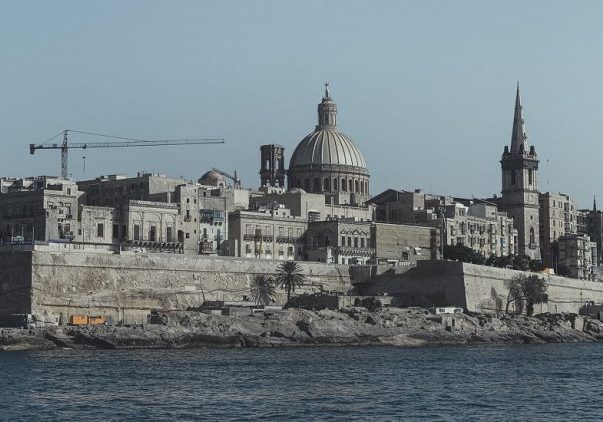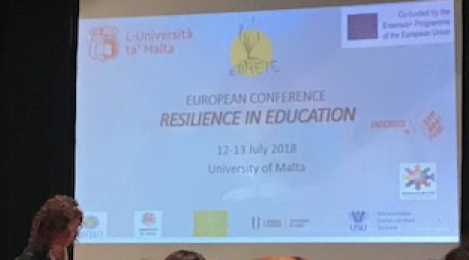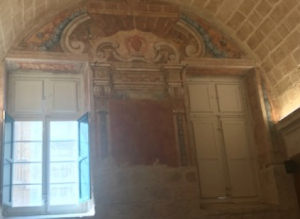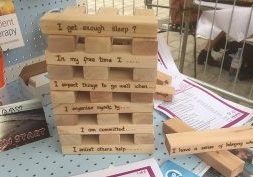Boingboing blogs from… Valletta, Malta
Thoughts on social justice informed approaches to resilience: European Conference on Resilience in Education, University of Malta, Valletta, July 2018
Welcome to Valletta, European City of Culture 2018. This is Anne Rathbone here – Southern European Correspondent for Boingboing and the Centre of Resilience for Social Justice (CRSJ). I am attending the European Conference on Resilience in Education, hosted by the University of Malta in partnership with Universities of Crete (Greece), Lisbon (Portugal), Pavia (Italy), Rijeka (Croatia), and Stefan cel Mare (Romania). I’ll be presenting later about our Academic Resilience Approach (ARA) as part of a focus here on systems-based schools resilience approaches, so I’ll let you know how that goes later.
First up is a presentation by students of St Ignatius College, Malta and a presentation to their Principal of a special award for resilience development work. The college has provided training to more than 100 staff members on integrating resilience development in schools. The resilient moves that the college is using in their training package have a strong ecological focus, especially in relation to belonging and learning. There are welcome references, in their acceptance speech, to the inequalities that some children and young people face. The Rector of the University of Malta addresses the conference next. He is speaking about the plight of refugees, facing loss of life travelling to Europe and then huge risks and adversity if they arrive here. Many are young children, and it’s imperative that, as a European community of countries, we implement the best possible strategies and practices to support them. Increasing economic and social stresses and inequalities facing many of our children (not only migrants), present us with massive challenges. I’m delighted to hear the Rector argue that the quest for resilience is a call for social justice, challenging inequalities and focusing on the most marginalised children. He is talking about resilience as resistance, and in believing in, and striving for, social change. There’s also a lot of emphasis in his speech on making sure research and public services are democratised as much as possible; that they respond directly to the needs of the community and result in direct impact in terms of changed practice and changed lives. This is music to my ears and really aligns with our approaches to resilience. I’m feeling glad not to be listening to presentations that individualise and pathologise children and young people, with limited ecological focus. They occur far too often at conferences I go to. The promise of a social justice approach is, of course, easier to say than do as we know from our own work. This includes the whole town ‘Resilience Revolution’ approach we are working with in Blackpool, UK. I wonder how this is all working in practice, and to what extent, in Malta. Hopefully I will find out more over the next two days. In the meantime, it’s humbling to stop and really think about the great challenges faced by Southern European countries in addressing the refugee crisis, with the support from richer economies limited. Yet they appear to have this strong vision around social justice here in Malta.
The Minister of Education, Malta is now speaking about how we shouldn’t confuse complex adversity with powerlessness. Complex adversity is largely societally engineered through socially unjust policies. We should be encouraging, and celebrating, young people’s power and agency, but to develop this they need to have opportunities in society and not be suppressed by harmful social and economic policies that keep them down. Economic and social policies need to be able to show how they underpin education and resilience strategies. Politicians must be accountable for the impact of their policies on the most marginalised children and families and be able to look them in the eye at the end of the day. Rousing words that, again, strongly resonate with the work of the Centre of Resilience for Social Justice (CRSJ) and Boingboing. I am starting the Resilience in Education conference prepared to be impressed.
The keynote presentation is by Prof. Michael Ungar who is speaking now on Nurturing Resilience Among Children, Young People and Families with Complex Needs. His aim in the presentation is to share some of the emerging ideas globally in relation to resilience. His opening, illustrative, story from his own practice, is of a young girl newly arrived in a community who wasn’t given any support to develop a sense of belonging. Nobody had helped to facilitate friendships for her, so she sought to solve the problem herself by stealing bags of sweets to share in the playground. The girl was judged and blamed by both her family and the school, rather than them recognising that she was merely adapting to an inadequate ecological environment. She was surviving in the best way she knew, in the absence of any adults recognising and addressing her needs. This has struck a chord with me, reminding me a bit of myself as a child and how, even today, a strong sense of belonging can enable me to thrive, whilst the lack of it brings out my shadow self. Social systems, of which schools play a part, are essential in promoting belonging and connectivity via a safe and engaging environment. This can mitigate the negative impacts of even quite complex adversity to promote resilience. Supportive systems are the cornerstones of resilience for the most marginalised children and young people.
Prof. Ungar is fond of fairy tales to illustrate resilience, I have learned, and he is now posing the question of whether the story of Cinderella is really about Cinderella at all, or whether it really about the Fairy Godmother. After all, without the Fairy Godmother coming up with the dress, the slippers, the coach and so on, Cinderella would never have gone to the ball at all. She might easily have ended up homeless, penniless and getting involved in prostitution or crime to survive. The anecdote doesn’t bear too much scrutiny on several levels, but the point is made. Those cute Disney mice, though well intentioned, didn’t have a lot of power to help, and Cinderella going it alone would have had her work cut out to survive.
So, all of this is leading toward Prof. Ungar’s familiar definition of the dynamic nature of the construct of resilience; that is, that it is the ability of the child or young person to navigate to, and negotiate for, support systems that are available. This makes me think afresh about what I think is lacking in emphasis in this definition by Ungar, which is that children and young people can’t navigate their way to support and negotiate it, if they can’t see who, what and where these support systems are. Services need to be not just available, but known about, visible, timely, welcoming, and confidence-inspiring. I wonder if Cinderella would have had enough of a sense of entitlement or energy to go out looking for the Fairy Godmother, if the said Fairy hadn’t appeared in a puff of smoke, right there in the kitchen. I doubt it, somehow, after all those years of negative messages and cleaning the grate.
Michael Ungar has now gone on to talk about his Nine Things All Children Need, which are reflective of aspects of the Resilience Framework. They are:
- Structure
- Consequences
- Parent-child connections (‘my parents are really proud of me for doing this’)
- Lots of and lots of strong relationships
- A powerful identity
- A sense of control
- A sense of belonging/spirituality/life purpose
- Rights and responsibilities
- Safety and support
I have heard him speak about these nine things quite a few times now, and I always like it. Today it is making me think in a new way about the links between these nine things and the developmental value of good co-production activities. Done well, co-production offers, in one way or another, opportunities for all these to be developed in individuals and groups. Some people (mainly with more traditional mental health backgrounds) have said to me that co-production isn’t an intervention. ‘Intervention’ or not, good co-production is embedded therapeutic practice. I’m inspired to think more about this, and the iterative links between individual and community development and the power to ‘change the odds’. We should have some really useful data on these very issues from our team at the CRSJ in a year or two.
We’ve all had lunch now and I’m about to present on our ARA and new schools guide on addressing mental health needs through a resilience based, whole school approach. First though, Pauline Miceli, Commissioner for Children here in Malta is talking about Rights and Resilience Building with a staff member from her office and one of the young people who is working with the Children’s Commissioner to co-produce resilience solutions and challenge policy makers to adopt them. Pauline works closely with the Centre of Resilience here at the University of Malta, Valletta on resilience through a lens of children’s rights. They believe that a rights-based approach supports the resilience of children and young people, and that those responsible for working with them should know about, and promote, the rights of children. The Children’s Commissioner provides an annual award for children who stand up for their own rights, and those of their peers. They provide a case work service for individual children and groups of children who feel that they are experiencing barriers accessing their right. Strategically and practically, they aim to have a strong focus on participation of children in everything that concerns them. They monitor the effect of government policies on children and young people. This leads to a fascinating and challenging discussion about the balance between protecting children from harm but also offering opportunities for positive risk taking through participation and acting for social change.
Now it is my turn to present on our Academic Resilience Approach, as a whole-systems approach for schools on resilience. There is a lot of interest in, and after, the presentation. This is coming from people working in schools, academics and strategic planners for education who are interested in learning more about the ARA, the Resilience Framework and our upcoming Guide for Schools on addressing mental health issues using a resilience approach. With such a plethora of resilience programmes out there for schools, it’s gratifying to have discussions with people who are recognising that the ARA is a strategic, wraparound approach of embedded practice, and so much more than a teacher training programme or curriculum-based programme (although of course these are very valuable in their own right). Well worth coming then, apart from the beautiful city, great people and sunshine. And to cap it all, this must be one of the nicest rooms in which I have ever given a presentation.
Ida Skytte Jakobsen is the person I have found most in common with at the conference. She’s a clinical psychologist and researcher from Denmark. She is speaking about her project ‘HOK’, which combines resilience, equity and personal development strategies into a whole school approach, which draws heavily on the ARA. The national school system in Demark has an explicit aim of promoting, emotional wellbeing, freedom and equality. Isn’t that great? For example, they manage school choice and limit early streaming of pupils to contribute to their equity approach. This is because the prevailing view in Denmark is that equity and resilience are closely interlinked. Not surprisingly then, Ida describes herself as ‘deeply interested’ in the Boingboing approach, seeing a resonance in our work with hers and with the Danish education systems. She has translated the Resilience Framework into Danish and called it Resilience and Equity Framework – how cool is that? She is interested in how to bring the two strands of resilience and equity together to find synergies that can help us understand the value of resilience through a social justice lens. It might just be about language, but Ida is the first person today that I have heard talking about young people as co-researchers and co-producers, rather than pupils or participants. All in all, a presentation that is very aligned with our messages.
It’s coming now to the end of the Resilience in Education conference, and the end of this blog. Respect to Professor Carmel Cefai and his team and partners for organising such a great event. Thanks to them and thanks to you for reading.
“In the context of exposure to significant adversity, resilience is both the capacity of individuals to navigate their way to the psychological, social, cultural, and physical resources that sustain their well-being, and their capacity individually and collectively to negotiate for these resources to be provided in culturally meaningful ways.” (Ungar, M.). http://www.resilienceproject.org/about-the-rrc/resilience/14-what-is-resilience Retrieved 13th July 2018.
http://depts.washington.edu/lend/pdfs/2017-03-06_6_Dr._M._Ungar_Brochure_Insert-Nine_Things_All_Children_Need.pdf Retrieved 13th July 2018.



